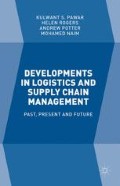Abstract
Today’s business environment and harsh competitiveness force companies and entire supply chains to increase their efficiency as much as possible. As a consequence, supply chains have become highly sensitive to disruptions and less tolerant to deviations in operations, that is, supply chains have become more vulnerable (see Kleindorfer and Saad, 2005). Vulnerability of supply chains may result in less consistent supply chain performances, and consequently, their competitive power in the market may diminish. In order to maintain stability of supply chain performances, it is necessary to design robust supply chains. Robust supply chains should be able to continue to function well in the event of a disruption as well as in the normal business environment (see Dong, 2006; Tang, 2006; Waters, 2007). Generally, robustness of the supply chain depends on its capability to respond adequately to different kinds of risks of disturbances. Recently, supply chain vulnerability and robustness has become a hot research topic, and as such, it is still in its infancy. With this paper, we aim to contribute to the existing knowledge in these areas.
Access this chapter
Tax calculation will be finalised at checkout
Purchases are for personal use only
Preview
Unable to display preview. Download preview PDF.
References
Asbjørnslett, B. E. and Rausand M. (1999) “Assess the vulnerability of your production system”, Production Planning & Control, 10(3), 219–229.
Dong, M. (2006) “Development of supply chain network robustness index”, International Journal of Services Operations and Informatics, 1(1/2), 54–66.
Hopp, W. J. (2008) Supply Chain Science, McGraw-Hill, New York.
Simchi-Levi, D., Kaminsky, P. and Simchi-Levi, E. (2008) Designing and managing the supply chain, Concepts, Strategies, and Case Studies, III Edition, McGraw-Hill, New York.
Tang, C. S. (2006a) “Perspectives in supply chain risk management”, International Journal of Production Economics, 103, 451–488.
Tomlin, B. (2006) “On the value of mitigation and contingency strategies for managing supply chain disruption risks”, Management Science, 52(5), 639–657.
Van der Vorst, J. G. A. J. and Beulens, A. J. M. (2002) “Identifying sources of uncertainty to generate supply chain redesign strategies”, International Journal of Physical Distribution & Logistic Management, 32(6), 409–430.
Waters, D. (2007) Supply Chain Risk Management: Vulnerability and Resilience in Logistics, Kogan Page Limited, London.
Zsidisin, G. A., Panelli, A. P. and Upton, R. (2000) “Purchasing organisation involvement in risk assessments, contingency plans, and risk management: an exploratory study”, Supply Chain Management: An International Journal, 5(4), 187–197. 27–37
Editor information
Editors and Affiliations
Copyright information
© 2016 Jelena V. Vlajic, Jack G. A. J. van der Vorst and Rene Haijema
About this chapter
Cite this chapter
Vlajic, J.V., van der Vorst, J.G.A.J., Haijema, R. (2016). Framework for Designing Robust Supply Chains. In: Pawar, K.S., Rogers, H., Potter, A., Naim, M. (eds) Developments in Logistics and Supply Chain Management. Palgrave Macmillan, London. https://doi.org/10.1057/9781137541253_2
Download citation
DOI: https://doi.org/10.1057/9781137541253_2
Publisher Name: Palgrave Macmillan, London
Print ISBN: 978-1-349-55848-3
Online ISBN: 978-1-137-54125-3
eBook Packages: Business and ManagementBusiness and Management (R0)

